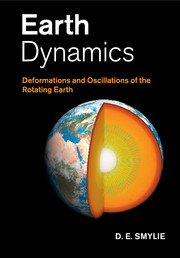Book contents
- Frontmatter
- Contents
- Preface and acknowledgments
- The book website www.cambridge.org/smylie
- 1 Introduction and theoretical background
- 2 Time sequence and spectral analysis
- 3 Earth deformations
- 4 Earth's rotation: observations and theory
- 5 Earth's figure and gravitation
- 6 Rotating fluids and the outer core
- 7 The subseismic equation and boundary conditions
- 8 Variational methods and core modes
- 9 Static deformations and dislocation theory
- Appendix A Elementary results from vector analysis
- Appendix B Properties of Legendre functions
- Appendix C Numerical Earth models
- References
- Fortran index
- Subject index
8 - Variational methods and core modes
Published online by Cambridge University Press: 05 March 2013
- Frontmatter
- Contents
- Preface and acknowledgments
- The book website www.cambridge.org/smylie
- 1 Introduction and theoretical background
- 2 Time sequence and spectral analysis
- 3 Earth deformations
- 4 Earth's rotation: observations and theory
- 5 Earth's figure and gravitation
- 6 Rotating fluids and the outer core
- 7 The subseismic equation and boundary conditions
- 8 Variational methods and core modes
- 9 Static deformations and dislocation theory
- Appendix A Elementary results from vector analysis
- Appendix B Properties of Legendre functions
- Appendix C Numerical Earth models
- References
- Fortran index
- Subject index
Summary
In the subseismic description of core dynamics, presented in the previous chapter, the changes in density caused by adiabatic compression or expansion due to transport through the hydrostatic pressure field are included, but those arising from flow pressure fluctuations are ignored in comparison. While this leads to the subseismic wave equation governing long-period core oscillations, the geophysicist's favourite analytical tool, the representation of solutions by expansion in spherical harmonics, is poorly convergent for such modes, due to tight Coriolis coupling between harmonics of like azimuthal number but differing zonal number (Johnson and Smylie, 1977). Instead, we use local polynomial basis functions to represent the generalised displacement potential. We show that solutions of the governing subseismic wave equation and boundary conditions have either purely even or purely odd symmetry across the equatorial plane. The basis functions then take the forms developed in Section 1.6.3. Solutions to the subseismic wave equation are found through the development of a variational principle, which includes the continuity of the normal component of displacement as a natural boundary condition of the problem (Smylie et al., 1992). The remaining elasto-gravitational boundary conditions are incorporated through the load Love numbers described in the previous chapter.
A subseismic variational principle
A variational principle for the subseismic wave equation, (7.24), will involve stationarity of the functional with respect to variations in the generalised displacement potential, χ, subject to boundary conditions. The vector displacement field is given by expression (7.16), entirely in terms of the gradient of the generalised displacement potential.
- Type
- Chapter
- Information
- Earth DynamicsDeformations and Oscillations of the Rotating Earth, pp. 445 - 481Publisher: Cambridge University PressPrint publication year: 2013



